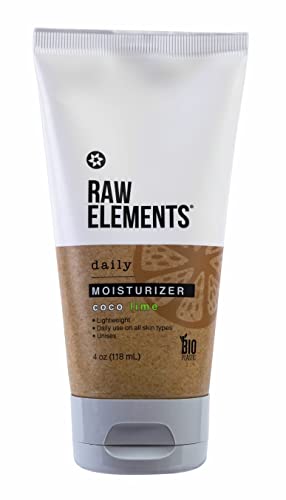
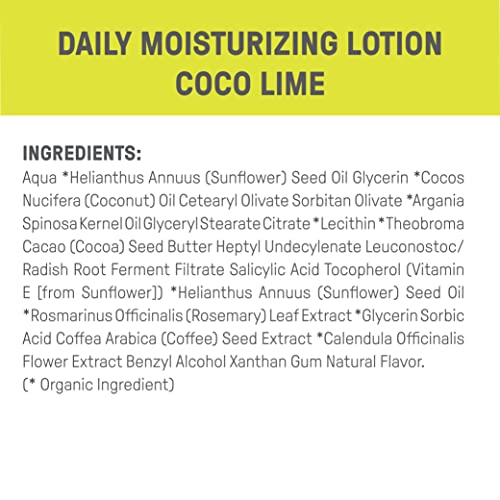
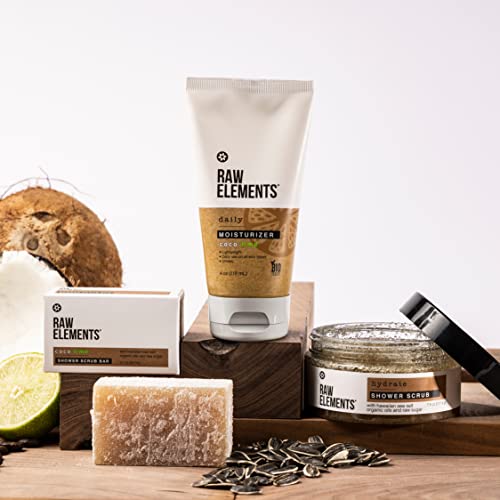
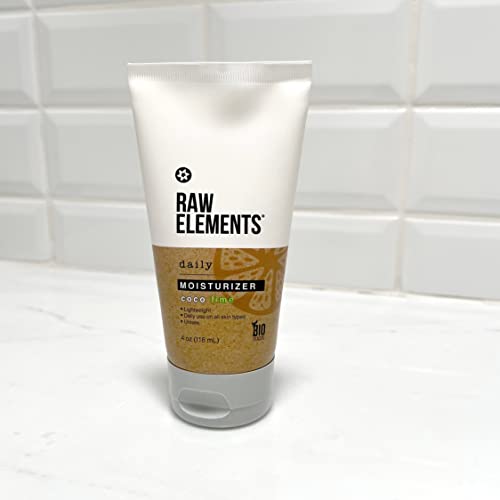
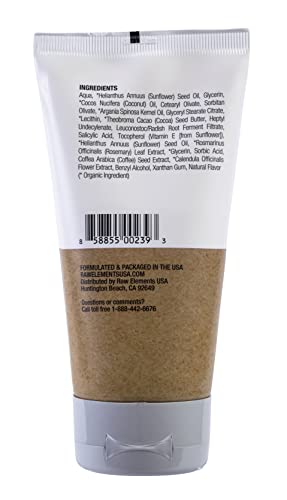
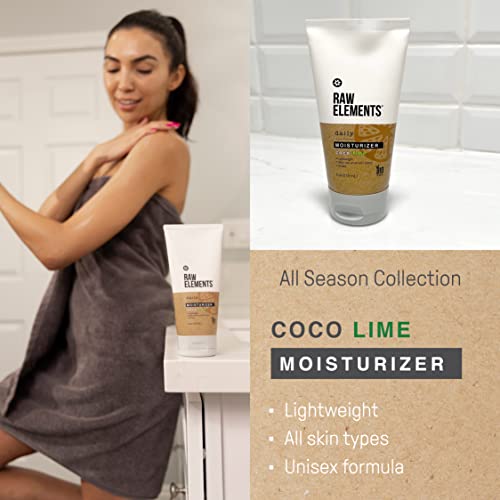
Raw Elements Daily Moisturizing Lotion - Hydrating Cocoa Butter & Vitamin E, Reef-Safe - 4oz


Salicylic Acid
High RiskSalicylic acid is a naturally occurring and synthetic compound primarily used in skincare products for its ability to exfoliate skin, unclog pores, and treat acne. It is a beta hydroxy acid (BHA) that penetrates the skin to effectively reduce inflammation and promote cell turnover.
Sustai Insights
Salicylic acid is recognized for its effective acne treatment properties and ability to enhance skin absorption, making it beneficial in various formulations. However, its use is subject to restrictions due to potential adverse health effects such as skin irritation and enhanced absorption risks. Regulatory bodies have cautioned against high concentrations, marking it as a high-risk ingredient. Special consideration should be given to sensitive populations, and safer alternatives like glycolic acid may be explored to minimize risks.
Benzyl Alcohol
High RiskBenzyl alcohol is a naturally occurring and synthetic aromatic alcohol commonly used as a solvent, preservative, and fragrance ingredient in various products. It is found in both plant sources and as a synthetic compound, functioning primarily to maintain product stability and enhance fragrance profiles.
Sustai Insights
Benzyl alcohol serves effectively as a preservative and solvent, contributing to product stability and sensory qualities. However, it poses potential health risks, particularly as an allergen, with high concern for immunotoxicity. Environmental risks include being a pollutant with low bioaccumulation potential. Regulatory agencies have established restrictions on its use in certain products. Overall, the risk level associated with benzyl alcohol is assessed as high, necessitating careful consideration of its use and potential alternatives.
Unspecified Flavor
Medium RiskUnspecified flavor refers to a term used by cosmetic manufacturers to denote a flavoring component in products. This ingredient functions primarily to enhance the sensory experience of the product, providing a pleasant taste or scent without specifying the exact composition of the flavoring agents used.
Sustai Insights
Unspecified flavor serves as an effective sensory enhancer in cosmetic products, adding taste or aroma without revealing specific ingredients. However, it may pose low health risks, including potential allergens or irritants, with no significant carcinogenic or reproductive toxicity concerns. Environmentally, it is not known to be bioaccumulative or a notable pollutant. Regulatory bodies impose minimal restrictions on its use. Given these factors, the overall risk level is assessed as medium, necessitating cautious use and consideration of potential safer alternatives.
Sorbic Acid
Medium RiskSorbic acid is a naturally occurring and synthetically produced compound primarily used as a preservative in food and cosmetic products. It effectively inhibits the growth of molds, yeasts, and some bacteria, thereby extending shelf life and maintaining product integrity.
Sustai Insights
Sorbic acid serves as an effective preservative, enhancing product longevity and safety. It is generally recognized as safe by the FDA and has a low risk for carcinogenicity, while exhibiting moderate allergenic potential. Environmental concerns include its potential as a pollutant, though it is not significantly bioaccumulative. Regulatory bodies impose few restrictions, indicating a moderate risk level overall. Safe usage practices should be followed, and alternatives like potassium sorbate may be considered for those seeking different options.
Lecithin
Medium RiskLecithin is a naturally occurring lipid found in various plant and animal tissues, primarily composed of phospholipids. It serves as an emulsifier, stabilizing mixtures of oil and water, and is commonly used in food, cosmetics, and pharmaceuticals to improve texture and extend shelf life.
Sustai Insights
Lecithin provides functional benefits as an effective emulsifier and stabilizer, enhancing product texture while being sustainably sourced from natural origins. Health risks are generally low, with moderate concerns regarding allergies and immunotoxicity but minimal cancer or reproductive toxicity risks. Environmental hazards are limited, and it is not classified as a pollutant. Regulatory bodies impose few restrictions. Overall, lecithin presents a medium risk, suggesting caution in usage, especially for sensitive individuals. Alternatives include sunflower lecithin or other plant-based emulsifiers that may offer similar benefits with reduced allergenic potential.
Rosmarinus Officinalis (Rosemary) Leaf Extract
Medium RiskRosemary leaf extract is produced from the leaves of the Rosmarinus officinalis plant. It is commonly used in cosmetic formulations for its potential antioxidant properties and fragrance. The extract may also contribute to the preservation of products due to its antimicrobial characteristics.
Sustai Insights
Rosemary leaf extract offers functional benefits such as antioxidant and antimicrobial properties, which can enhance product stability and shelf-life. It is generally considered low risk for carcinogenicity and reproductive toxicity, but it carries a moderate potential for allergic reactions. Environmentally, it poses low risk with no significant pollutant or bioaccumulation concerns. Regulatory bodies have not placed significant restrictions on its use, although some verified products cannot contain certain concentrations. Overall, the ingredient's risk level is medium, necessitating careful usage practices to mitigate allergic responses.
Glycerin
Medium RiskGlycerin (also called glycerol) is a naturally occurring compound commonly used in personal care and cosmetic products. It functions as a humectant, attracting moisture to the skin, and is also utilized as a solvent and emollient to enhance product texture and stability.
Sustai Insights
Glycerin is valued for its effective moisturizing properties and biodegradability, making it a widely accepted ingredient in formulations. It poses low health risks, including low concerns for carcinogenicity and allergies. However, moderate use restrictions exist due to regulatory guidelines. While glycerin does not significantly contribute to environmental pollution, its production process should be ethically sourced. Overall, glycerin holds a medium risk level, emphasizing the importance of safe usage practices and considering sustainable alternatives.
Leuconostoc/Radish Root Ferment Filtrate
Low RiskLeuconostoc/radish root ferment filtrate is a natural fermentation product derived from radish roots, commonly used in skincare for its potential preservative properties and skin-conditioning benefits. It functions by harnessing the metabolic activity of Leuconostoc bacteria to provide a source of beneficial compounds.
Sustai Insights
This ingredient offers functional benefits, primarily as a preservative and skin-conditioning agent, while being biodegradable and sustainably sourced. Health risks are generally low, with no significant concerns regarding carcinogenicity or allergies, though contamination concerns exist. Environmentally, it poses minimal risks, categorized as low overall risk based on current scientific consensus. Safe usage practices are advised, and alternatives may include other natural preservatives like tocopherol or rosemary extract.
Coffea Arabica (Arabian Coffee) Seed Extract
Low RiskCoffea arabica (coffee) seed extract is an extract derived from the seeds of the Coffea arabica plant, commonly used in cosmetic and personal care products for its antioxidant properties and potential skin conditioning benefits.
Sustai Insights
Coffea arabica seed extract provides functional benefits as an antioxidant, potentially improving skin health. It has low associated health risks, including carcinogenicity and allergenic potential, and is not currently restricted by regulatory bodies like the FDA. Environmental impacts are minimal, with no significant pollutant or bioaccumulative concerns. Overall, the ingredient presents a low risk, supporting its safe use in formulations.
Calendula Officinalis (Pot Marigold) Flower Extract
Low RiskExtract of the Calendula (Calendula officinalis) flower, commonly known as pot marigold, is utilized in cosmetic formulations for its soothing and anti-inflammatory properties. It is often included in creams, lotions, and ointments to promote skin health and healing.
Sustai Insights
Calendula officinalis flower extract offers functional benefits such as skin soothing and anti-inflammatory effects, making it valuable in topical applications. It is considered low risk for health impacts, with minimal concerns regarding carcinogenicity, allergies, or reproductive toxicity. Environmentally, it presents low pollution potential and is not bioaccumulative. Regulatory bodies have not imposed significant restrictions. Safe usage practices should be followed, and while alternatives exist, this extract is generally regarded as a low-risk option for cosmetic use.
Glyceryl Stearate Citrate
Low RiskGlyceryl stearate citrate is a citric acid ester of glycerol and stearic acid, commonly used as an emulsifier and stabilizer in cosmetic formulations. It helps blend oil and water components, enhancing product texture and consistency.
Sustai Insights
Glyceryl stearate citrate offers functional benefits as an effective emulsifier, improving product stability and texture. It is considered safe, with low concerns for cancer, allergies, and reproductive toxicity. However, it may cause skin irritation in some individuals. Environmental risks are minimal, with no significant bioaccumulation or pollutant potential. Regulatory bodies have not placed significant restrictions on its use. Overall, the ingredient is assessed as low risk, with safe usage practices recommended, and alternatives may include other emulsifiers like cetearyl alcohol.
10 Undecenoic Acid, Heptyl Ester
Low Risk10 Undecenoic Acid, Heptyl Ester is an ester derived from undecenoic acid and heptanol. It is primarily used in cosmetic formulations due to its emollient properties, contributing to product texture and skin feel.
Sustai Insights
This ingredient offers functional benefits as an emollient, enhancing product application and texture. It has low health risks, with no significant concerns for carcinogenicity, allergies, or reproductive toxicity. Environmental risks are minimal, with no evidence of pollutant potential or bioaccumulation. Regulatory bodies have not placed significant restrictions on its use. Overall, it is assessed as low risk, with safe usage practices recommended. Alternatives may include other plant-based esters or synthetic emollients that provide similar benefits.
Theobroma Cacao (Cocoa) Seed Butter
Low RiskTheobroma cacao (cocoa) seed butter is extracted from the roasted seeds of the cocoa plant. It is commonly used in cosmetics and skincare products for its emollient properties, helping to moisturize and soften the skin. Cocoa butter is also known for its stability and resistance to rancidity.
Sustai Insights
Cocoa butter is recognized for its effective moisturizing properties and is sustainably sourced, contributing to its appeal in personal care products. It poses low health risks, with minimal concerns regarding carcinogenicity, allergies, or reproductive toxicity. Environmentally, it does not significantly contribute to pollution or bioaccumulation. Regulatory bodies impose few restrictions, affirming its safety. Overall, the risk associated with cocoa seed butter is low, making it a favorable ingredient in cosmetics. Alternatives include shea butter or plant oils for similar emollient benefits.
Argania Spinosa (Argan) Kernel Oil
Low RiskArgania spinosa (argan) kernel oil is a fixed oil extracted from the kernels of the argan tree, native to Morocco. It is commonly used in cosmetic formulations for its moisturizing properties, serving as an emollient and skin conditioner.
Sustai Insights
Argania spinosa kernel oil offers functional benefits such as effective hydration and nourishment for the skin and hair. It is sustainably sourced and biodegradable, contributing positively to environmental considerations. Health risks are low, with minimal concerns regarding carcinogenicity, allergies, or reproductive toxicity. There are no current regulatory restrictions on its use. Overall, it poses low risk, making it a suitable ingredient in cosmetic products. Safe usage practices should be maintained, and alternatives like jojoba oil may also be considered for similar benefits.
Sorbitan Olivate
Low RiskSorbitan olivate is a surfactant derived from olive oil and sorbitol. It functions primarily as an emulsifier, allowing for the mixing of oil and water in cosmetic formulations. It is commonly found in creams and lotions, enhancing texture and stability.
Sustai Insights
Sorbitan olivate offers functional benefits as an emulsifier, improving product texture and stability while being derived from a sustainable source. Health risks are low, with no significant concerns regarding carcinogenicity, allergies, or reproductive toxicity. Environmentally, it is not known to bioaccumulate or contribute to pollution. Regulatory bodies have not identified restrictions, indicating a favorable risk level. For safe usage, it is recommended in standard cosmetic formulations, with few alternatives necessary given its low-risk profile.
Cetearyl Olivate
Low RiskCetearyl olivate is composed of cetearyl alcohol and the fatty acids derived from olive oil. It is primarily used as an emulsifier and skin-conditioning agent in cosmetic formulations, helping to stabilize and enhance the texture of creams and lotions.
Sustai Insights
Cetearyl olivate serves as an effective emulsifier, contributing to product stability and texture. It is derived from olive oil, making it a sustainable choice due to its biodegradable nature. Health concerns are low, with minimal risks for irritation and allergies. Regulatory status is favorable, with no significant warnings. Environmental risks are also low, indicating it does not pose substantial hazards. Overall, the ingredient presents a low risk profile, making it a safe option in cosmetic products.
Water
Low RiskWater is a clear, colorless liquid essential for various biological processes. It serves as a solvent in formulations, facilitating the dissolution of other ingredients and enhancing product texture and application. Additionally, water plays a crucial role in hydration and is a key component in many cosmetic and personal care products.
Sustai Insights
Water is an effective solvent and hydrator, contributing to the texture and efficacy of formulations. It is biodegradable and generally regarded as safe, with low concerns regarding carcinogenicity, allergies, and reproductive toxicity. However, excessive water usage can lead to environmental concerns, particularly regarding resource depletion. Regulatory bodies do not impose restrictions on water use in cosmetics. Overall, the risks associated with water are low, making it a safe and essential ingredient.
Tocopherol
Low RiskTocopherols are a class of naturally occurring compounds, primarily known for their role as antioxidants. They are commonly used in cosmetic and skincare products to help stabilize formulations and protect ingredients from oxidative damage.
Sustai Insights
Tocopherols provide functional benefits such as antioxidant protection and skin conditioning. They are generally recognized as safe, with low concerns regarding carcinogenicity, allergies, and reproductive toxicity. However, enhanced skin absorption and potential endocrine disruption are noted. Regulatory bodies have not imposed significant restrictions on tocopherols, categorizing the overall risk as low. Safe usage practices should be observed, and while alternatives exist, tocopherols remain a viable option in formulations.
Xanthan Gum
Low RiskXanthan gum is a polysaccharide, a sugar-based compound produced by the fermentation of glucose or sucrose. It is commonly used as a thickening agent and stabilizer in various food and cosmetic products due to its ability to improve texture and prevent ingredient separation.
Sustai Insights
Xanthan gum serves effectively as a thickener and stabilizer, enhancing product texture and consistency. It is biodegradable and typically derived from renewable sources, supporting sustainability efforts. Health risks are minimal, with low concerns regarding carcinogenicity, allergies, and reproductive toxicity. Environmental impact is similarly low, posing no significant hazards. Regulatory agencies, including the FDA, regard it as safe for use, with no significant restrictions. Overall, xanthan gum is assessed as low risk, making it a suitable ingredient in formulations.
Cocos Nucifera (Coconut) Oil
Low RiskCocos Nucifera (Coconut) Oil is derived from the kernels of the coconut palm. It is primarily used in cosmetic formulations for its emollient and moisturizing properties, making it suitable for skin and hair care products.
Sustai Insights
Coconut oil serves as an effective moisturizer and emollient, promoting skin hydration and softness. It is sustainably sourced and biodegradable. Health risks are minimal, with low concerns regarding carcinogenicity, allergens, and reproductive toxicity. Environmental impact is also low, as it does not contribute significantly to pollution or bioaccumulation. Regulatory bodies have not issued restrictions on its use. Overall, coconut oil presents a low risk for health and environmental concerns, making it a safe ingredient in cosmetic products.
Helianthus Annuus (Sunflower) Seed Oil
Low RiskHelianthus annuus (sunflower) seed oil is derived from the seeds of the sunflower plant. It serves primarily as an emollient and moisturizer in cosmetic formulations, helping to maintain skin hydration and improve texture.
Sustai Insights
Sunflower seed oil is effective as an emollient, providing moisture and improving skin texture while being biodegradable and sustainably sourced. It poses low health risks, including negligible concerns for carcinogenicity, allergies, or reproductive toxicity. Environmentally, it does not significantly contribute to pollution or bioaccumulation. Regulatory bodies currently do not list any advisories for this ingredient. Overall, it is assessed as low risk, with safe usage practices recommended. Alternatives include oils like jojoba or almond oil for those seeking different properties.
Unspecified Flavor
Medium RiskUnspecified flavor refers to a term used by cosmetic manufacturers to denote a flavoring component in products. This ingredient functions primarily to enhance the sensory experience of the product, providing a pleasant taste or scent without specifying the exact composition of the flavoring agents used.
Sustai Insights
Unspecified flavor serves as an effective sensory enhancer in cosmetic products, adding taste or aroma without revealing specific ingredients. However, it may pose low health risks, including potential allergens or irritants, with no significant carcinogenic or reproductive toxicity concerns. Environmentally, it is not known to be bioaccumulative or a notable pollutant. Regulatory bodies impose minimal restrictions on its use. Given these factors, the overall risk level is assessed as medium, necessitating cautious use and consideration of potential safer alternatives.
Leuconostoc/Radish Root Ferment Filtrate
Low RiskLeuconostoc/radish root ferment filtrate is a natural fermentation product derived from radish roots, commonly used in skincare for its potential preservative properties and skin-conditioning benefits. It functions by harnessing the metabolic activity of Leuconostoc bacteria to provide a source of beneficial compounds.
Sustai Insights
This ingredient offers functional benefits, primarily as a preservative and skin-conditioning agent, while being biodegradable and sustainably sourced. Health risks are generally low, with no significant concerns regarding carcinogenicity or allergies, though contamination concerns exist. Environmentally, it poses minimal risks, categorized as low overall risk based on current scientific consensus. Safe usage practices are advised, and alternatives may include other natural preservatives like tocopherol or rosemary extract.
Coffea Arabica (Arabian Coffee) Seed Extract
Low RiskCoffea arabica (coffee) seed extract is an extract derived from the seeds of the Coffea arabica plant, commonly used in cosmetic and personal care products for its antioxidant properties and potential skin conditioning benefits.
Sustai Insights
Coffea arabica seed extract provides functional benefits as an antioxidant, potentially improving skin health. It has low associated health risks, including carcinogenicity and allergenic potential, and is not currently restricted by regulatory bodies like the FDA. Environmental impacts are minimal, with no significant pollutant or bioaccumulative concerns. Overall, the ingredient presents a low risk, supporting its safe use in formulations.
Calendula Officinalis (Pot Marigold) Flower Extract
Low RiskExtract of the Calendula (Calendula officinalis) flower, commonly known as pot marigold, is utilized in cosmetic formulations for its soothing and anti-inflammatory properties. It is often included in creams, lotions, and ointments to promote skin health and healing.
Sustai Insights
Calendula officinalis flower extract offers functional benefits such as skin soothing and anti-inflammatory effects, making it valuable in topical applications. It is considered low risk for health impacts, with minimal concerns regarding carcinogenicity, allergies, or reproductive toxicity. Environmentally, it presents low pollution potential and is not bioaccumulative. Regulatory bodies have not imposed significant restrictions. Safe usage practices should be followed, and while alternatives exist, this extract is generally regarded as a low-risk option for cosmetic use.
Salicylic Acid
High RiskSalicylic acid is a naturally occurring and synthetic compound primarily used in skincare products for its ability to exfoliate skin, unclog pores, and treat acne. It is a beta hydroxy acid (BHA) that penetrates the skin to effectively reduce inflammation and promote cell turnover.
Sustai Insights
Salicylic acid is recognized for its effective acne treatment properties and ability to enhance skin absorption, making it beneficial in various formulations. However, its use is subject to restrictions due to potential adverse health effects such as skin irritation and enhanced absorption risks. Regulatory bodies have cautioned against high concentrations, marking it as a high-risk ingredient. Special consideration should be given to sensitive populations, and safer alternatives like glycolic acid may be explored to minimize risks.
Glyceryl Stearate Citrate
Low RiskGlyceryl stearate citrate is a citric acid ester of glycerol and stearic acid, commonly used as an emulsifier and stabilizer in cosmetic formulations. It helps blend oil and water components, enhancing product texture and consistency.
Sustai Insights
Glyceryl stearate citrate offers functional benefits as an effective emulsifier, improving product stability and texture. It is considered safe, with low concerns for cancer, allergies, and reproductive toxicity. However, it may cause skin irritation in some individuals. Environmental risks are minimal, with no significant bioaccumulation or pollutant potential. Regulatory bodies have not placed significant restrictions on its use. Overall, the ingredient is assessed as low risk, with safe usage practices recommended, and alternatives may include other emulsifiers like cetearyl alcohol.
10 Undecenoic Acid, Heptyl Ester
Low Risk10 Undecenoic Acid, Heptyl Ester is an ester derived from undecenoic acid and heptanol. It is primarily used in cosmetic formulations due to its emollient properties, contributing to product texture and skin feel.
Sustai Insights
This ingredient offers functional benefits as an emollient, enhancing product application and texture. It has low health risks, with no significant concerns for carcinogenicity, allergies, or reproductive toxicity. Environmental risks are minimal, with no evidence of pollutant potential or bioaccumulation. Regulatory bodies have not placed significant restrictions on its use. Overall, it is assessed as low risk, with safe usage practices recommended. Alternatives may include other plant-based esters or synthetic emollients that provide similar benefits.
Theobroma Cacao (Cocoa) Seed Butter
Low RiskTheobroma cacao (cocoa) seed butter is extracted from the roasted seeds of the cocoa plant. It is commonly used in cosmetics and skincare products for its emollient properties, helping to moisturize and soften the skin. Cocoa butter is also known for its stability and resistance to rancidity.
Sustai Insights
Cocoa butter is recognized for its effective moisturizing properties and is sustainably sourced, contributing to its appeal in personal care products. It poses low health risks, with minimal concerns regarding carcinogenicity, allergies, or reproductive toxicity. Environmentally, it does not significantly contribute to pollution or bioaccumulation. Regulatory bodies impose few restrictions, affirming its safety. Overall, the risk associated with cocoa seed butter is low, making it a favorable ingredient in cosmetics. Alternatives include shea butter or plant oils for similar emollient benefits.
Argania Spinosa (Argan) Kernel Oil
Low RiskArgania spinosa (argan) kernel oil is a fixed oil extracted from the kernels of the argan tree, native to Morocco. It is commonly used in cosmetic formulations for its moisturizing properties, serving as an emollient and skin conditioner.
Sustai Insights
Argania spinosa kernel oil offers functional benefits such as effective hydration and nourishment for the skin and hair. It is sustainably sourced and biodegradable, contributing positively to environmental considerations. Health risks are low, with minimal concerns regarding carcinogenicity, allergies, or reproductive toxicity. There are no current regulatory restrictions on its use. Overall, it poses low risk, making it a suitable ingredient in cosmetic products. Safe usage practices should be maintained, and alternatives like jojoba oil may also be considered for similar benefits.
Sorbitan Olivate
Low RiskSorbitan olivate is a surfactant derived from olive oil and sorbitol. It functions primarily as an emulsifier, allowing for the mixing of oil and water in cosmetic formulations. It is commonly found in creams and lotions, enhancing texture and stability.
Sustai Insights
Sorbitan olivate offers functional benefits as an emulsifier, improving product texture and stability while being derived from a sustainable source. Health risks are low, with no significant concerns regarding carcinogenicity, allergies, or reproductive toxicity. Environmentally, it is not known to bioaccumulate or contribute to pollution. Regulatory bodies have not identified restrictions, indicating a favorable risk level. For safe usage, it is recommended in standard cosmetic formulations, with few alternatives necessary given its low-risk profile.
Sorbic Acid
Medium RiskSorbic acid is a naturally occurring and synthetically produced compound primarily used as a preservative in food and cosmetic products. It effectively inhibits the growth of molds, yeasts, and some bacteria, thereby extending shelf life and maintaining product integrity.
Sustai Insights
Sorbic acid serves as an effective preservative, enhancing product longevity and safety. It is generally recognized as safe by the FDA and has a low risk for carcinogenicity, while exhibiting moderate allergenic potential. Environmental concerns include its potential as a pollutant, though it is not significantly bioaccumulative. Regulatory bodies impose few restrictions, indicating a moderate risk level overall. Safe usage practices should be followed, and alternatives like potassium sorbate may be considered for those seeking different options.
Lecithin
Medium RiskLecithin is a naturally occurring lipid found in various plant and animal tissues, primarily composed of phospholipids. It serves as an emulsifier, stabilizing mixtures of oil and water, and is commonly used in food, cosmetics, and pharmaceuticals to improve texture and extend shelf life.
Sustai Insights
Lecithin provides functional benefits as an effective emulsifier and stabilizer, enhancing product texture while being sustainably sourced from natural origins. Health risks are generally low, with moderate concerns regarding allergies and immunotoxicity but minimal cancer or reproductive toxicity risks. Environmental hazards are limited, and it is not classified as a pollutant. Regulatory bodies impose few restrictions. Overall, lecithin presents a medium risk, suggesting caution in usage, especially for sensitive individuals. Alternatives include sunflower lecithin or other plant-based emulsifiers that may offer similar benefits with reduced allergenic potential.
Rosmarinus Officinalis (Rosemary) Leaf Extract
Medium RiskRosemary leaf extract is produced from the leaves of the Rosmarinus officinalis plant. It is commonly used in cosmetic formulations for its potential antioxidant properties and fragrance. The extract may also contribute to the preservation of products due to its antimicrobial characteristics.
Sustai Insights
Rosemary leaf extract offers functional benefits such as antioxidant and antimicrobial properties, which can enhance product stability and shelf-life. It is generally considered low risk for carcinogenicity and reproductive toxicity, but it carries a moderate potential for allergic reactions. Environmentally, it poses low risk with no significant pollutant or bioaccumulation concerns. Regulatory bodies have not placed significant restrictions on its use, although some verified products cannot contain certain concentrations. Overall, the ingredient's risk level is medium, necessitating careful usage practices to mitigate allergic responses.
Cetearyl Olivate
Low RiskCetearyl olivate is composed of cetearyl alcohol and the fatty acids derived from olive oil. It is primarily used as an emulsifier and skin-conditioning agent in cosmetic formulations, helping to stabilize and enhance the texture of creams and lotions.
Sustai Insights
Cetearyl olivate serves as an effective emulsifier, contributing to product stability and texture. It is derived from olive oil, making it a sustainable choice due to its biodegradable nature. Health concerns are low, with minimal risks for irritation and allergies. Regulatory status is favorable, with no significant warnings. Environmental risks are also low, indicating it does not pose substantial hazards. Overall, the ingredient presents a low risk profile, making it a safe option in cosmetic products.
Water
Low RiskWater is a clear, colorless liquid essential for various biological processes. It serves as a solvent in formulations, facilitating the dissolution of other ingredients and enhancing product texture and application. Additionally, water plays a crucial role in hydration and is a key component in many cosmetic and personal care products.
Sustai Insights
Water is an effective solvent and hydrator, contributing to the texture and efficacy of formulations. It is biodegradable and generally regarded as safe, with low concerns regarding carcinogenicity, allergies, and reproductive toxicity. However, excessive water usage can lead to environmental concerns, particularly regarding resource depletion. Regulatory bodies do not impose restrictions on water use in cosmetics. Overall, the risks associated with water are low, making it a safe and essential ingredient.
Glycerin
Medium RiskGlycerin (also called glycerol) is a naturally occurring compound commonly used in personal care and cosmetic products. It functions as a humectant, attracting moisture to the skin, and is also utilized as a solvent and emollient to enhance product texture and stability.
Sustai Insights
Glycerin is valued for its effective moisturizing properties and biodegradability, making it a widely accepted ingredient in formulations. It poses low health risks, including low concerns for carcinogenicity and allergies. However, moderate use restrictions exist due to regulatory guidelines. While glycerin does not significantly contribute to environmental pollution, its production process should be ethically sourced. Overall, glycerin holds a medium risk level, emphasizing the importance of safe usage practices and considering sustainable alternatives.
Tocopherol
Low RiskTocopherols are a class of naturally occurring compounds, primarily known for their role as antioxidants. They are commonly used in cosmetic and skincare products to help stabilize formulations and protect ingredients from oxidative damage.
Sustai Insights
Tocopherols provide functional benefits such as antioxidant protection and skin conditioning. They are generally recognized as safe, with low concerns regarding carcinogenicity, allergies, and reproductive toxicity. However, enhanced skin absorption and potential endocrine disruption are noted. Regulatory bodies have not imposed significant restrictions on tocopherols, categorizing the overall risk as low. Safe usage practices should be observed, and while alternatives exist, tocopherols remain a viable option in formulations.
Xanthan Gum
Low RiskXanthan gum is a polysaccharide, a sugar-based compound produced by the fermentation of glucose or sucrose. It is commonly used as a thickening agent and stabilizer in various food and cosmetic products due to its ability to improve texture and prevent ingredient separation.
Sustai Insights
Xanthan gum serves effectively as a thickener and stabilizer, enhancing product texture and consistency. It is biodegradable and typically derived from renewable sources, supporting sustainability efforts. Health risks are minimal, with low concerns regarding carcinogenicity, allergies, and reproductive toxicity. Environmental impact is similarly low, posing no significant hazards. Regulatory agencies, including the FDA, regard it as safe for use, with no significant restrictions. Overall, xanthan gum is assessed as low risk, making it a suitable ingredient in formulations.
Benzyl Alcohol
High RiskBenzyl alcohol is a naturally occurring and synthetic aromatic alcohol commonly used as a solvent, preservative, and fragrance ingredient in various products. It is found in both plant sources and as a synthetic compound, functioning primarily to maintain product stability and enhance fragrance profiles.
Sustai Insights
Benzyl alcohol serves effectively as a preservative and solvent, contributing to product stability and sensory qualities. However, it poses potential health risks, particularly as an allergen, with high concern for immunotoxicity. Environmental risks include being a pollutant with low bioaccumulation potential. Regulatory agencies have established restrictions on its use in certain products. Overall, the risk level associated with benzyl alcohol is assessed as high, necessitating careful consideration of its use and potential alternatives.
Cocos Nucifera (Coconut) Oil
Low RiskCocos Nucifera (Coconut) Oil is derived from the kernels of the coconut palm. It is primarily used in cosmetic formulations for its emollient and moisturizing properties, making it suitable for skin and hair care products.
Sustai Insights
Coconut oil serves as an effective moisturizer and emollient, promoting skin hydration and softness. It is sustainably sourced and biodegradable. Health risks are minimal, with low concerns regarding carcinogenicity, allergens, and reproductive toxicity. Environmental impact is also low, as it does not contribute significantly to pollution or bioaccumulation. Regulatory bodies have not issued restrictions on its use. Overall, coconut oil presents a low risk for health and environmental concerns, making it a safe ingredient in cosmetic products.
Helianthus Annuus (Sunflower) Seed Oil
Low RiskHelianthus annuus (sunflower) seed oil is derived from the seeds of the sunflower plant. It serves primarily as an emollient and moisturizer in cosmetic formulations, helping to maintain skin hydration and improve texture.
Sustai Insights
Sunflower seed oil is effective as an emollient, providing moisture and improving skin texture while being biodegradable and sustainably sourced. It poses low health risks, including negligible concerns for carcinogenicity, allergies, or reproductive toxicity. Environmentally, it does not significantly contribute to pollution or bioaccumulation. Regulatory bodies currently do not list any advisories for this ingredient. Overall, it is assessed as low risk, with safe usage practices recommended. Alternatives include oils like jojoba or almond oil for those seeking different properties.
Experience the enchanting allure of Raw Elements Daily Moisturizing Lotion in Coco Lime. This organic, non-toxic body lotion not only pampers your skin but also supports your eco-conscious lifestyle with its reef-safe and water-resistant formula.
- Hydration and Nourishment: Infused with vitamin E and coconut oil, this lotion delivers a refreshing burst of hydration, perfect for daily body care.
- Eco-Friendly Packaging: Packaged in a bio-resin tube made from sustainable sugarcane, showcasing a commitment to environmental preservation.
- Luxurious Feel: Enjoy a lightweight, luxurious texture that transforms your skincare routine into a tropical oasis experience.
- All Skin Types: Specifically formulated to be suitable for all skin types, ensuring a gentle yet effective moisturizing experience.
- Daily Use: Ideal for reapplication after showering or swimming, this lotion keeps your skin hydrated while leaving a captivating Coco Lime scent.
Embrace a healthier, sustainable choice for your skin with Raw Elements, where indulgence meets environmental consciousness.
Subscribe & Save with Sustai
- Best Price Guarantee: Always enjoy the lowest prices on sustainable home essentials.
- No Surprises: We’ll notify you before shipping. No hidden fees, ever.
- You’re in Charge: Change, pause, or cancel your subscription anytime with ease.
- Eco-Friendly Deliveries: Our grouped shipments mean less packaging and lower emissions.
Join us on a sustainable journey. Special offers for a limited time! Prices and promotions may change.
Recommended Products
Experience the enchanting allure of Raw Elements Daily Moisturizing Lotion in Coco Lime. This organic, non-toxic body lotion not only pampers your skin but also supports your eco-conscious lifestyle with its reef-safe and water-resistant formula.
- Hydration and Nourishment: Infused with vitamin E and coconut oil, this lotion delivers a refreshing burst of hydration, perfect for daily body care.
- Eco-Friendly Packaging: Packaged in a bio-resin tube made from sustainable sugarcane, showcasing a commitment to environmental preservation.
- Luxurious Feel: Enjoy a lightweight, luxurious texture that transforms your skincare routine into a tropical oasis experience.
- All Skin Types: Specifically formulated to be suitable for all skin types, ensuring a gentle yet effective moisturizing experience.
- Daily Use: Ideal for reapplication after showering or swimming, this lotion keeps your skin hydrated while leaving a captivating Coco Lime scent.
Embrace a healthier, sustainable choice for your skin with Raw Elements, where indulgence meets environmental consciousness.

You can have at most 2 Sustainable Steals products in your cart
Customer Reviews
Customers’ View
Customers generally express satisfaction with the Raw Elements Organic Body Lotion, highlighting its lightweight texture and effective hydration. Many appreciate the pleasant Coco Lime scent, noting that it provides a refreshing tropical experience without being overwhelming. Users have reported that the lotion absorbs quickly, leaves no greasy residue, and is suitable for daily use on various skin types. A few customers mentioned concerns regarding the product's packaging, specifically the amount of lotion in the tube, with some feeling it appears underfilled. Additionally, a small contingent noted that the scent could be too strong for sensitive noses. Overall, customers find this body lotion to be a beneficial addition to their skincare routine, aligning well with eco-conscious and health-oriented values, particularly due to its organic ingredients and sustainable packaging.
AI-generated from the text of customer reviewsThis product has no reviews yet.




